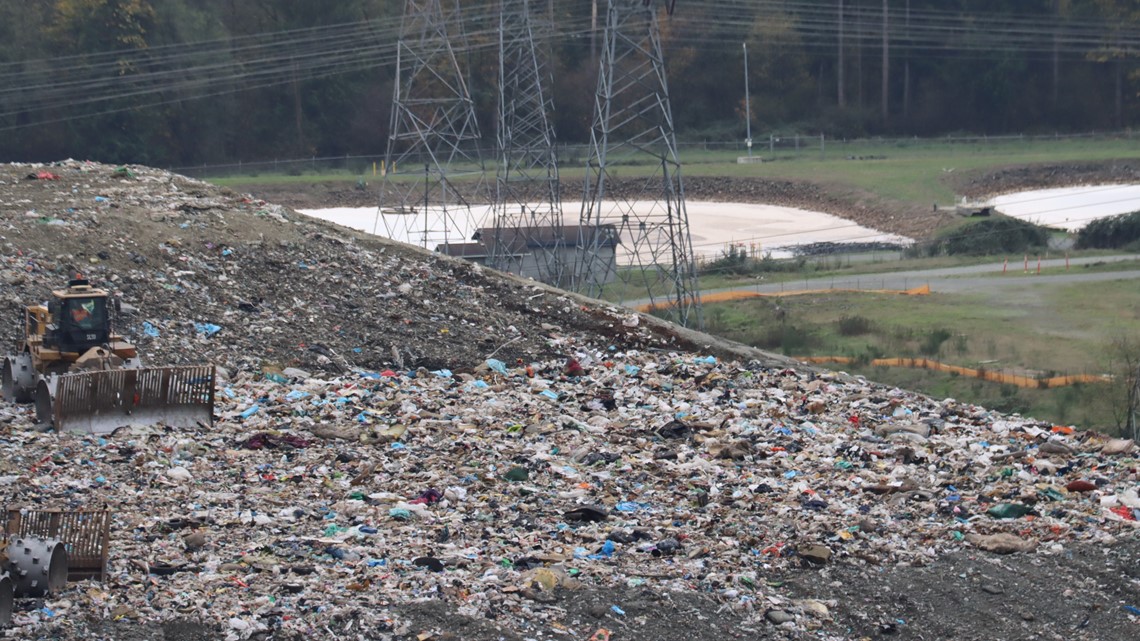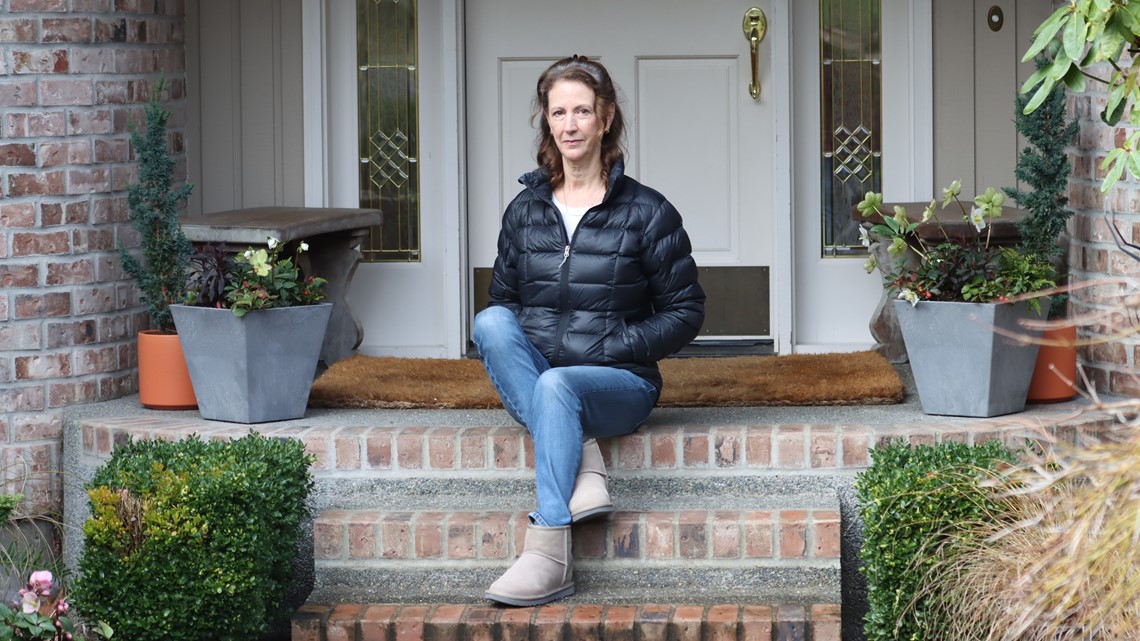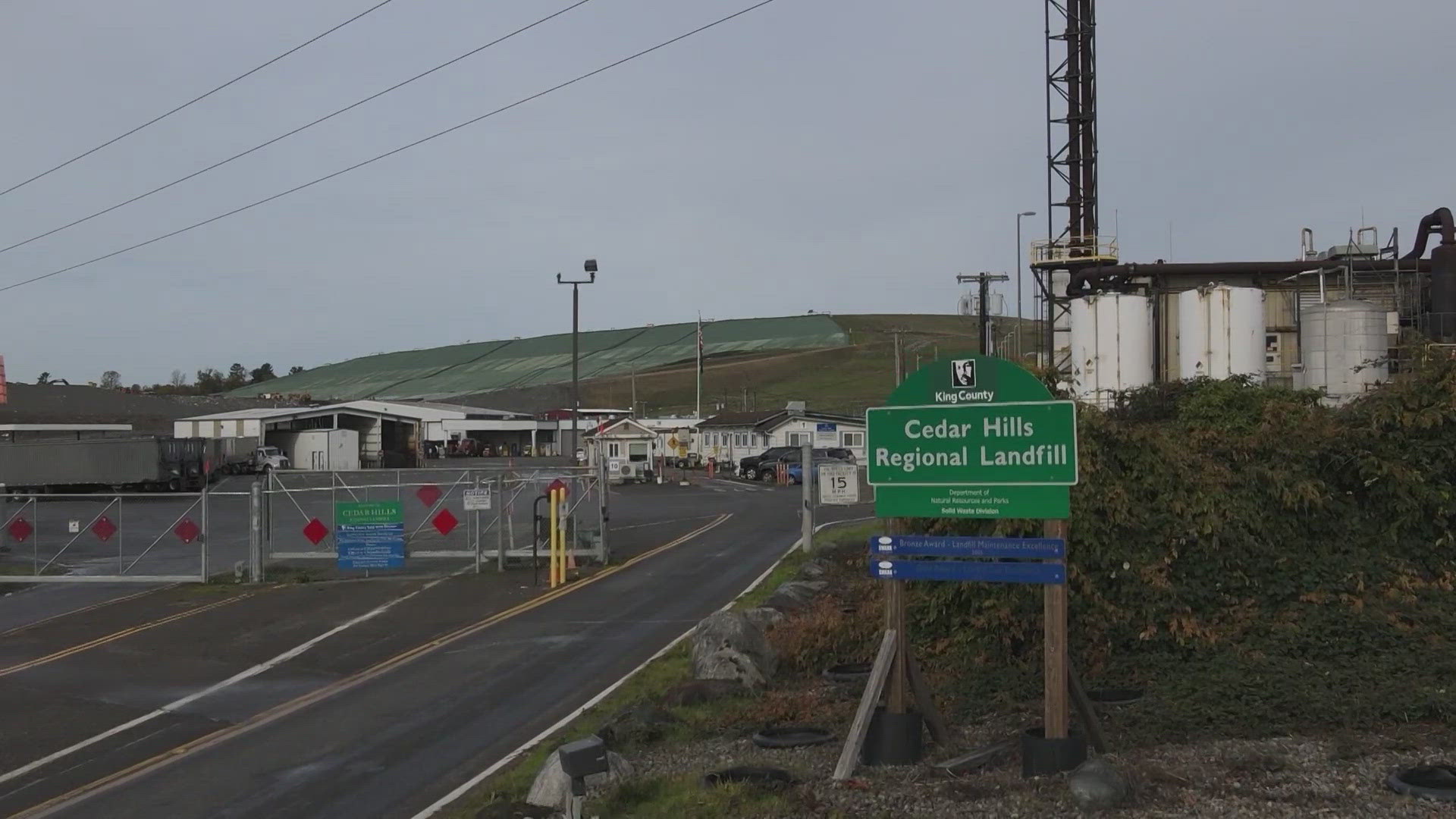MAPLE VALLEY, Wash. — A recent King County analysis of arsenic at the Cedar Hills Regional Landfill predicted arsenic emissions in a small area that extends into the community may exceed safe breathing limits put in place to protect the public.
The King County Solid Waste Division, which manages Cedar Hills, collected air samples above two lagoons in the southwest part of the Maple Valley facility. The lagoons hold the landfill’s wastewater, also known as “leachate.” According to the test results, some of the air samples contained arsenic levels more than two times higher than safe breathing limits, which regulators refer to as “Acceptable Source Impact Level” (ASIL) limits.
Based on those air samples, county consultants performed an analysis using scientific modeling and predicted airborne arsenic emissions could exceed ASIL limits at the nearby fence line and past the Cedar Hills’ border, according to a review of the King County reports.
King County’s study came in response to a historic directive from the Puget Sound Clean Air Agency (PSCAA), which monitors air quality in King, Kitsap, Pierce and Snohomish counties. In November, the agency issued an administrative order that required King County to complete a comprehensive analysis of airborne arsenic emissions at Cedar Hills to assess any potential risks to the public.
“I have deep concerns about the results,” said Jacquelyn Green, who lives with her family in a Renton neighborhood that borders Cedar Hills.
Thousands of people in Maple Valley, Issaquah and Renton live near Cedar Hills, which has come under scrutiny for a years-long arsenic problem that stems from its process of managing landfill gas – a byproduct of decomposing trash.


‘I am concerned there is a health risk’
The issue, at the center of a multi-part KING 5 investigation, has drawn attention from multiple regulatory agencies, in addition to health and safety complaints from Cedar Hills employees and neighbors.
Years before PSCAA required Cedar Hills to conduct an analysis of airborne arsenic, King County repeatedly discovered high levels of arsenic in the wastewater at Cedar Hills – violating state and local rules that exist to protect the environment and public health. King County is currently in a legal battle with a private contractor, Bio Energy Washington (BEW), over who is responsible for the arsenic in the wastewater.
Leslie Morgan, who lives in a Renton home near the landfill, said King County's analysis of airborne arsenic “validates” her community’s years of concerns about air quality and potential exposure to toxic pollutants, like arsenic. For decades, she and neighbors have filed hundreds of complaints with the clean air agency about poor air quality and negative health impacts from Cedar Hills’ operations.


“The concern is very real in our community,” she said. “You feel this really heavy weight that, ‘I have my family in this community. Are they safe?’... I am concerned that there is a health risk.”
Public Health – Seattle & King County previously said arsenic at Cedar Hills doesn’t pose a health threat. In response to the latest Cedar Hills analysis, a public health department spokesperson said the agency is deferring to PSCAA to reach a conclusion about any public health impacts from air quality issues at the landfill.
“We have reached out to PSCAA for further discussion and interpretation of these results,” wrote Kate Cole, spokesperson for Public Health – Seattle & King County, in a statement.
Steve Van Slyke, PSCAA’s director of compliance, said the agency is still reviewing the county’s findings, and that it hasn’t made a decision on next steps or issued a formal response.
“I would hope that they would require more thorough investigation outside of [Cedar Hills’] boundaries and into the surrounding communities,” said Renton resident Morgan, adding that she wants PSCAA inspectors to also conduct more frequent inspections of Cedar Hills in light of her community’s deep concerns. “They have a lot of work to do to gain our trust, and this is one way they could do it.”
In a May 21 letter sent to PSCAA, along with hundreds of pages of Cedar Hills test results and reports, King County Solid Waste Division Director Pat McLaughlin emphasized that the area near the lagoons was the only section where the county’s analysis identified an exceedance of ASIL limits. In addition to the wastewater lagoons, King County’s analysis evaluated potential sources of arsenic from landfill gas flare emissions and fugitive emissions of uncontrolled landfill gas.
“Our modeling of emissions from landfill sources other than leachate lagoons are well below the acceptable source impact levels,” wrote Joseph Basile, a King County spokesperson.
King County to conduct ‘further monitoring’ in area where arsenic exceedances possible
Basile said King County’s modeling, which predicted ASIL exceedances near Cedar Hills’ wastewater lagoons and the nearby fence line, used a “conservative methodology” out of an “abundance of caution,” and it “possibly overestimated” the amount of arsenic that exists in the air.
The King County Solid Waste Division asked PSCAA to issue an “enforceable order” that would require King County to refine its Cedar Hills analysis to determine whether its modeling predictions reflect actual conditions at the landfill, and to use the best available technology to address any exceedances of safe breathing limits.
“We will continue to work with PSCAA and other regulators as needed to ensure we demonstrate our commitment to protecting human health and the environment,” Basile wrote.
As King County awaits a formal response from the clean air agency, Cedar Hills officials said they are already planning to conduct “further monitoring” of the area where its modeling predicted levels above ASIL limits.
Doug Williams, a spokesperson for the King County Solid Waste Division, said Cedar Hills will begin collecting the air samples this week. He said the county will begin lab work and analysis “right away,” but there’s not a firm estimate for when it will be completed.
“If an exceedance is detected, we will pursue additional monitoring and control methods to ensure regulatory compliance and maintain the health and safety of the neighboring community,” wrote Williams in a statement on July 18.
Analysis did not focus on worker exposure to arsenic
The PSCAA-required air testing didn’t focus on safe breathing limits for workers. It focused on breathing standards for the public, which are more stringent due to the fact that the community is exposed to the air for much longer than an 8-hour shift.
“The report submitted to PSCAA modeled emission at and beyond the landfill property fence line,” wrote Williams in a statement. “This modeling was not designed to estimate air pollutants within the landfill or employee exposure.”
Pat McClauglin, director of the King County Solid Waste Division, has repeatedly assured workers that arsenic levels at the landfill don’t pose a health threat to workers.
However, landfill employees disagreed with King County leaders, including a truck driver and three King County engineers who were closely involved in the county’s efforts to deal with the arsenic problem. They accused the county of failing to protect workers and the public from the highly toxic chemical and inadequately assessing the potential risk of exposure.


The county said it hired independent experts who conducted employee air monitoring in December, and the testing showed “no detectable airborne arsenic levels.”
Williams, the King County spokesperson, said Cedar Hills has developed a bi-annual plan to conduct similar employee exposure testing moving forward, and it will conduct its next round of worker tests this week.
“This testing will provide more information on employee exposure and determine if there are any weather-related differences in airborne arsenic levels,” he said.

